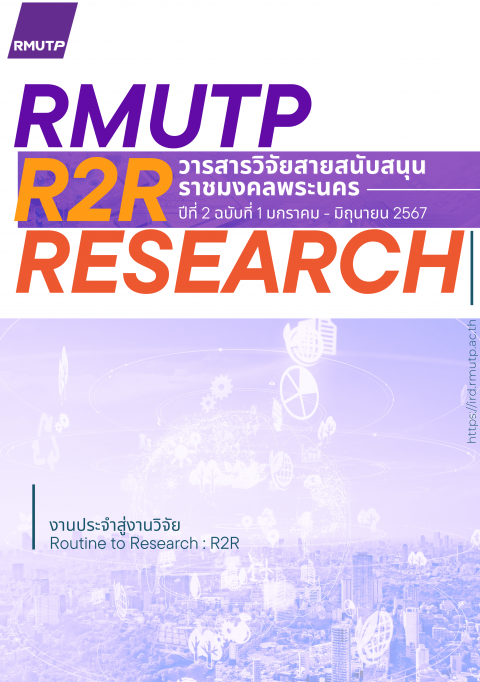Factor Analysis Effecting Interactive of Augmented Reality for Public Relations Brochure Media Tourist Attractions
Main Article Content
Abstract
The purposes of this research were to 1. factor analysis affected the interactivity of augmented reality media, 2. factor analysis the image size factor that affects the interactivity of augmented reality media, and 3) factor analysis the resolution factor Images affecting the interactive interaction of augmented reality media. This research was research and development. Tools used in the study included Artivive application and graphic program for editing images of tourist attraction publicity brochures. The results of the study found that 1. shade factors affecting the interactive interaction of augmented reality media. It was found that shades with minimal interactive interaction to no interactive interaction at all. This was caused by the color shades that affect the clarity of the image by making the image less sharp. 2. Image size factors affecting interactive interaction of augmented reality media. It was found that image size affects interactive interaction. It was found that the size of the images with the least interactive interaction to no interactive interaction at all. This was caused by the nature of the image size affecting the clarity of the image by making the image less sharp. 3. The resolution factor of the image that affects the interactive interaction of augmented reality media. It was found that the resolution of the image affects the interactive interaction. It was found that the resolution of images with minimal interactive interaction to no interactive interaction at all. This is caused by the nature of the image size affecting the clarity of the image by making the picture less sharp.
Article Details
ลิขสิทธิ์ ของมหาวิทยาลัยเทคโนโลยีราชมงคลพระนคร
References
ณัฐกมล ถุงสุวรรณ. (2561). การสร้างสรรค์สื่อประชาสัมพันธ์ด้วยสื่อสิ่งพิมพ์ร่วมกับสื่ออินเทอร์แอคทีฟ กรณีศึกษา:
สื่อประชาสัมพันธ์ในรูปแบบเกม AR สำหรับสาขาการออกแบบอินเทอร์แอคทีฟและเกม. วารสารศิลปกรรมบูรพา. 21(1-2). 229-247.
ปิยะมาศ แก้วเจริญ และวริสรา ธีรธัญปิยศุภร. (2559). การพัฒนาเทคโนโลยีเสมือนจริงในสื่อแผ่นพับเรื่อง เทคโนโลยีคอมพิวเตอร์. วารสารวิชาการ มหาวิทยาลัยกรุงเทพธนบุรี. 5(1). 68-81.
พันธมิตร ถือชาติ. (2560). การพัฒนาสื่อการเรียนรู้ ด้วยเทคโนโลยีความจริงเสริมบนระบบปฏิบัติการแอนดรอยด์ เรื่อง ระบบสุริยะ. (ปริญญาวิทยาศาสตรบัณฑิต). บุรีรัมย์. มหาวิทยาลัยราชภัฏบุรีรัมย์. สืบค้นจาก https://dspace.bru.ac.th/
xmlui/bitstream/handle/123456789/5
เรืองนภา ชอไชยทิศ ศุมรรษตรา แสนวา และ ดุษฎี สีวังคำ. (2564). การพัฒนาสื่อการเรียนรู้โดยใช้เทคโนโลยีความจริงเสริมเรื่องแนะนำการใช้บริการของสำนักหอสมุดกลาง มหาวิทยาลัยศรีนครินทรวิโรฒ. วารสารบรรณศาสตร์ มศว. 14(2). 60-75.
วงเดือน พลอยงาม และศุภพักตร์ จารุเศรณี. (2561). สื่อโฆษณาบนแผ่นเสมือน 3 มิติ ผ่านทางสมาร์ทโฟนสำหรับจัดแสดง
ในนิทรรศการท่องเที่ยว. วารสารวิทยาการและเทคโนโลยีสารสนเทศ. 8(2). 37-45.
ศุภกิตติ โสภาสพ. (2560). การพัฒนาเทคนิคการตรวจจับพื้นที่ใบหน้าและวัตถุบริเวณดวงตาโดยใช้การระมวลผลภาพ (วิทยานิพนธ์ปริญญามหาบัณฑิต). ปทุมธานี. มหาวิทยาลัยเทคโนโลยีราชมงคลธัญบุรี. สืบค้นจาก http://www.repository.rmutt.ac.th/xmlui/bitstream/123456789/3132/1/RMUTT-156711.pdf
ศูนย์วิจัยกสิกรไทย. (2560). เทคโนโลยีช่วย SME โตไม่หยุด ยุคดิติทัล. สืบค้นจาก https://www.kasikornbank.com/th/business
/sme/KSMEKnowledge/article/KSMEAnalysis/Documents/Technology-helps-SME-in-digital-age.pdf
any i Media. (2566). เทคโนโลยี Interactive คืออะไร เมื่อ สื่อปฏิสัมพันธ์เชิงโต้ตอบ' เข้ามามีบทบาทใน การศึกษา และการ จัดอีเวนต์มากยิ่งขึ้น. สืบค้นจาก https://anyimedia.com/what-is-interactive technology-when-it-becomes-more-important-in-education-and-events


